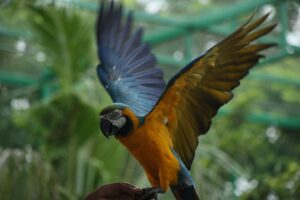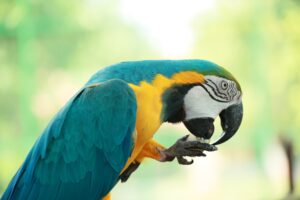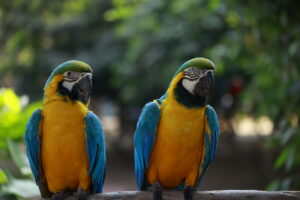The blue and gold macaw, also known as the blue and yellow macaw (scientific name: Ara ararauna), is a large and vibrant parrot species native to South America. Here are some key characteristics and information about the blue and gold macaw:
Physical Appearance:
– The blue and gold macaw is one of the largest species of parrots, measuring about 76-86 centimeters (30-34 inches) in length from beak to tail.
– Its most distinguishing feature is its beautiful plumage. The upper parts of its body, including the wings and back, are a brilliant blue color, while the underparts are bright yellow.
– It has a strong, curved beak that is black and grayish-white facial patches around its eyes.
– The blue and gold macaw has long, pointed wings and a long, tapering tail.
Habitat:
– Blue and gold macaws are native to the tropical rainforests of South America, including countries such as Brazil, Bolivia, Paraguay, and Peru.
– They inhabit various forested areas, including lowland forests, river edges, and savannas with palm groves.
Behavior and Diet:
– These macaws are highly social birds and usually form large flocks, which can consist of up to 30 individuals.
– They are known for their loud and raucous calls, which are used for communication within the flock.
– Blue and gold macaws are primarily herbivorous, feeding on a variety of fruits, nuts, seeds, berries, and palm fruits. They also consume clay from river banks, which helps them neutralize toxins present in their diet.
Reproduction:
– Blue and gold macaws form monogamous pairs that mate for life. They engage in elaborate courtship displays, including vocalizations, head bobbing, and wing flapping.
– The female typically lays two or three eggs in a tree cavity, and both parents take turns incubating the eggs for about 25-28 days.
– After hatching, the chicks are dependent on their parents for several months and gradually fledge and become independent.
Conservation Status:
– The blue and gold macaw is listed as a species of Least Concern on the IUCN Red List, which means it is not currently facing imminent extinction.
– However, like many other parrot species, it faces threats such as habitat loss due to deforestation, illegal pet trade, and hunting. These factors have led to local population declines in some areas.
Blue and gold macaws are highly intelligent, social, and strikingly beautiful birds. Their vibrant colors and engaging personalities make them popular in aviculture, but it’s important to ensure that they are acquired legally and from responsible sources, as the illegal pet trade poses a significant threat to their populations in the wild.



